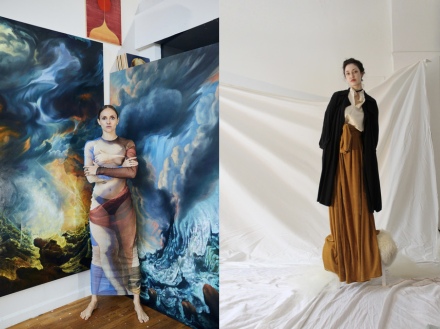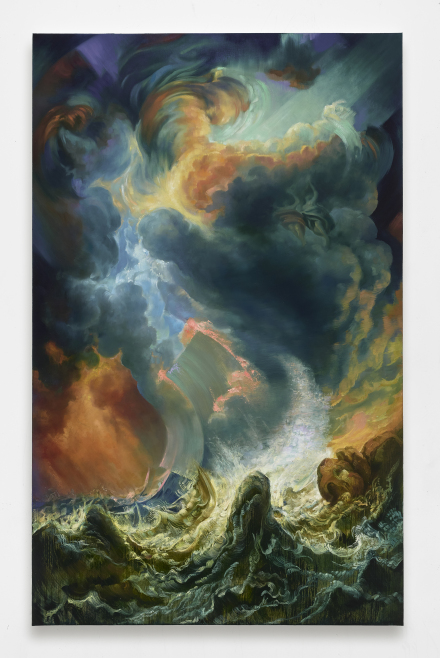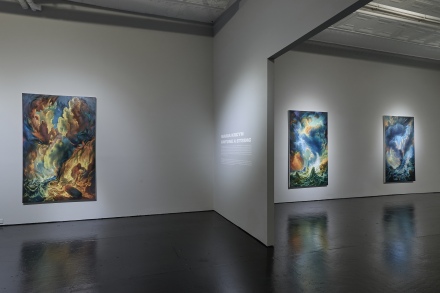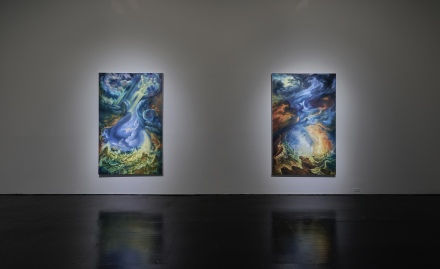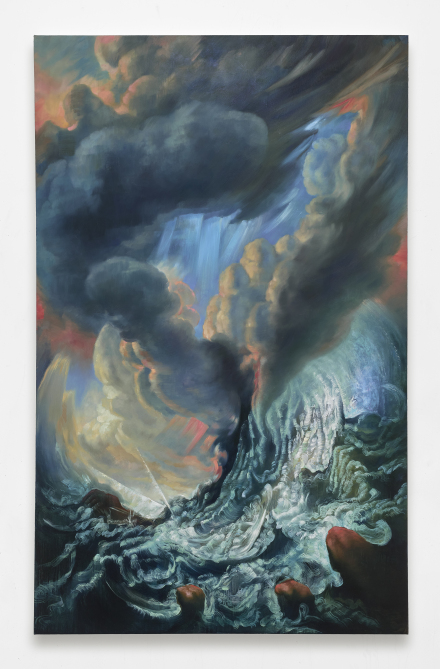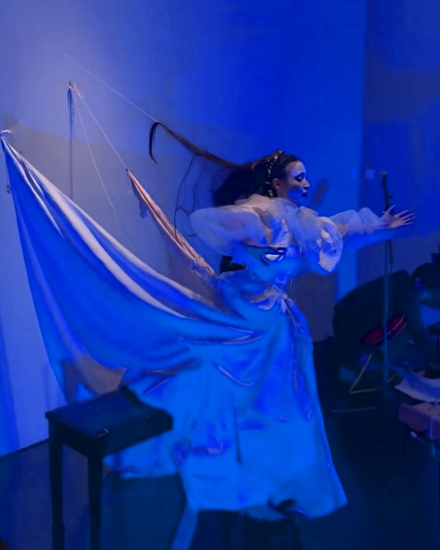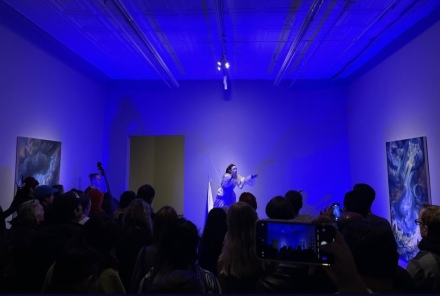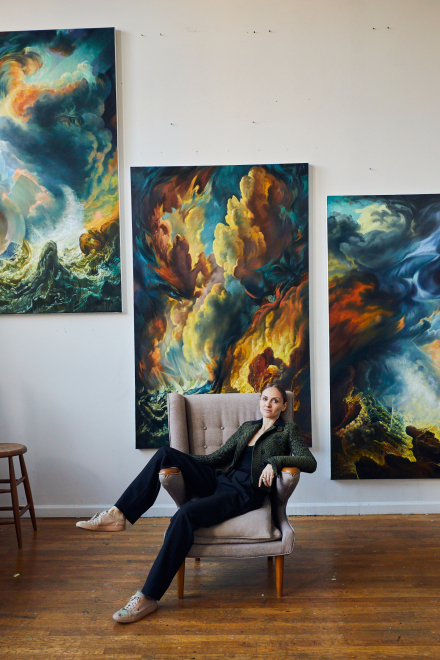Cover images courtesy of Ola Wilk via Maria Kreyn; and Ellen Frances.
For its first artist-on-artist interview, Art Observed sat down with New York-based painter Maria Kreyn and multidisciplinary artist and performer Ellen Frances to talk about their individual practices and their collaboration for the opening of Kreyn’s solo show Untune a String at The Hole in Tribeca earlier this month. In their conversation with Art Observed, the two artists discuss the importance of multidisciplinary collaboration, the enduring resonance of classical artistic and literary forms, and their visions for the future.
ANFISA VRUBEL (ART OBSERVED)– I’d like to start with your respective artistic backgrounds to get a sense of how your practices developed over time. Maria, you’re a painter, and your style re-envisions a particular classical sensibility and even some baroque influences. Your latest show Untune a String at The Hole brings together a series of sweeping landscape paintings that pay homage to these past styles and techniques, remixed with a more contemporary abstraction. I also found them to be allegorical. Can you tell us about your artistic journey and how it evolved into its current expression, with its push and pull between the past and present?
MARIA KREYN – My work definitely has a lot of old master and baroque influences, which is the type of painting that I was looking at when I was growing up. When I first started painting, I was entirely focused on the figure but after a decade, I had this really beautiful project that fell into my lap somewhat spontaneously. Andrew Lloyd Webber found my work and commissioned a cycle of eight paintings, all of which are based on Shakespeare and are now on permanent display in London’s oldest theater, in the lobby of Drury Lane. The series continued in that old master style but with a twist. It was a contemporary allegory of ideas and themes that are well-known from literature, reimagined in a contemporary setting. Removing the figure wasn’t so much about creating abstract paintings, it was about zooming out of the face and out of portraiture, zooming out of focusing on the hands and the body and seeing if the gesture of the climate, the atmosphere and this larger sense of the space that we inhabit can be a metaphor for the figure itself, as well as for the mind that lives inside the figure.
Image: Maria Kreyn Past is Prologue, 2023, oil on linen. Courtesy of The Hole Gallery.
ANFISA VRUBEL – In these times especially, I feel it’s apt to re-shift the focus away from the individual in a sense and capture the forces that we feel we are subject to but which are so vast and abstract in their scale that they evade our understanding, like the climate or deep geological time. You mentioned Shakespeare. Are there any other particular references and themes that appear in your work?
MARIA KREYN – Yeah, definitely. Ovid’s Metamorphosis comes up a lot. I had an entire series that was based on that, called Chasing Memory. The thought behind it was taking something very familiar and deeply ingrained in our culture and then scrambling it, revising and reframing it to tell a very different story. It’s playing with something familiar and pushing toward the archetype that gives you a sense of the universality of the human experience. We’re living in this swirl of stories that we’re building our identity from.
ANFISA VRUBEL – Yes, we seem to be inundated by stories. There was a piece about you in Vanity Fair in which you described some of your paintings as “altarpieces.” In what ways are your paintings extensions of your spiritual sensibility, or what you consider to be universal?
MARIA KREYN – Painting is kind of the deepest meditation that I have. It’s the deepest flow state that I can find so my paintings are altarpieces in that way. It’s a very non-denominational altarpiece, the least hierarchical idea of the divine that I could come up with. It’s a deep meditation on being a body and existing as a human in time, and the ability to create a portal into what feels like a beautiful and spatially deep world. Ideally, it will feel like a space to which you can come home, even if that space is turbulent. There is still a kind of peace inside of them.
ANFISA VRUBEL – They’re projections of an inner world, but you also give space for the subjective interpretation. Whoever is looking at the painting can find their own depths in it. How do you prepare to create a painting? What does that process look like for you?
MARIA KREYN – I gather a lot of references, and I read and do research. I spend a lot of time in mental pre-production where I rehearse how I’m going to create the image so by the time I go to paint it, I’m thinking as little as possible and just let the thing happen.
ANFISA VRUBEL – So you meditate on the idea first and then the process takes over?
MARIA KREYN – For sure. At first, the brush is a thing that you have to learn how to handle and then it becomes an extension of your hand. And then you get to play because you’re not thinking about what you’re doing that much. Of course, you’re thinking and calculating but it’s that flow state that becomes a kind of meditation. That’s why I think it’s possible to make a contemporary “altarpiece” that isn’t pushing an ideology but rather creates a space that resonates with another human being.
ANFISA VRUBEL – We’re so fragmented in how we look at our day-to-day lives. It’s fragmented by technology, the ceaseless flow of information. As an artist and a creative, you have to have something that grounds your perspective and distills the tempest that you have inside. That we all have inside.
Image courtesy of The Hole Gallery.
MARIA KREYN – Yeah, it’s a question of our common humanity, right? Because the more you zoom out, the more you realize that we’re just little dots on a planet and that planet is a little dot in the cosmos. It’s that feeling of “as above, so below.” What happens inside is mirrored by what happens outside. The logic and the math of both of those spaces somehow either equate or just rhyme, but they are very similar. It’s just a matter of vantage point and scale. I haven’t quite figured out how to zoom out beyond the planet, as far as image-making goes. Maybe that’s step two, right? [Laughs.]
ANFISA VRUBEL – Totally. The next logical progression. Ellen, your practice encompasses performance, dancing, painting, and writing. I’m especially fascinated by the fact that you create your own costumes and choreography, as you told me at the opening of the show. You’re also a ballet dancer. How do you weave these disciplines into a single whole? Do you look at them as being integrated or is there a separation for you?
ELLEN FRANCES – I’ve always felt that they’re integrated but I am asked quite often if I favor one over the other. In the end, they all feed into each other. I journal for hours every day and I write poetry, and that brings to mind images that inspire paintings and the paintings then inspire the costumes. It’s something that happens naturally as an extension of my writing.
ANFISA VRUBEL – And I think performance is having a major resurgence right now, perhaps because it gives something visceral to the audience. It’s a singular way of connecting the audience with the artist’s creative process. I liked what you did together with Maria for the opening of the show at The Hole. I think there was an interesting conversation that happened between her paintings and your performance. How did you two meet?
ELLEN FRANCES – I take ballet class pretty regularly and sometimes I take open classes for people of all levels. At one of these classes during the pandemic, I met and became friends with a woman who happened to know Maria. I had heard about Maria’s work and so one day we went over to see where Maria worked in her loft. I was very taken with the subject matter. As you mentioned, I grew up in the classical ballet world. I was trained by George Balanchine’s protégé, Todd Bolender, as well as people from the Ballets Russes and the Bolshoi Ballet. So this classical sentiment was ingrained in me from the time I was very young. When I saw Maria’s work and listened to her talk about it, it resonated with my lifelong love of these classical art forms and antiquity. I think we connected on that level, and also in terms of literature and ways of looking at mysticism and spirituality. I was immediately a fan.
Image courtesy of The Hole Gallery.
ANFISA VRUBEL – It’s interesting to see how your respective mediums reinforce that connection. Where did you grow up, Ellen? Were your parents also artistic?
ELLEN FRANCES – I was kind of out of place in my family [laughs]. I was born in Missouri, and I spent part of the time on a farm in Kansas and part of the time in Kansas City. By the time I was twelve, I left home to train with Galina Yordanova from the Bolshoi Ballet when she was teaching at the Royal Winnipeg Ballet. When I moved to New York, I became involved in the underground downtown art scene, moving between circles in writing, art, music, and dance for quite a while.
ANFISA VRUBEL – And when did you decide to pursue painting and performance?
ELLEN FRANCES – I always painted. Even when I was in grade school, I would make these hour-long performances for which I created the costumes, painted the backdrops, and performed for everyone after dinner. It’s always been my thing. I’ve always been very poetic and dramatic. My family thought it was interesting but it definitely didn’t come from them. It came from some other place, I’m not sure where [laughs]. What was your creative upbringing like, Maria?
MARIA KREYN – My family and I are from Russia, and I feel like that cultural heritage has been the bedrock of everything that has come since. I was also taken to museums from a young age so I grew up with these images, sounds, and words that shaped my mind. And honestly, it never even occurred to me to go to art school. I knew I was going to be an artist but that I wouldn’t do it through the avenue of formal schooling. My formal education is in math and philosophy, which I studied at the University of Chicago. After two years of that, I decided to start painting. It was now or never. I watched a lot of talented people work, and I learned mostly through observation and years of tinkering.
Image: Maria Kreyn Plume, 2023, oil on linen. Courtesy of The Hole Gallery.
ELLEN FRANCES – Why are the classical arts something that you focus on not just in your paintings but also as the inspiration for your paintings? Where does that come from?
MARIA KREYN – My mom is a classical pianist so I basically grew up under a piano. Classical is a tough word because it denotes a specific period. What draws me to that old master way of painting is the profound sense of the paintings feeling truly alive without actually being super naturalistic. They really grip me emotionally. It’s so powerful having that resonance with an image through this lineage because you feel like you’re in a conversation with someone who was working hundreds of years ago, in the same way that you can be in conversation with a writer when you’re reading their books.
ANFISA VRUBEL – Especially living in a hyper-real world saturated with so many images, it’s important to preserve that connection to the past. Maybe that style of painting offers a realistic representation without being “too real,” in a way.
MARIA KREYN – Yeah, for sure. We live in a world that’s very disposable. As a culture and a civilization, we produce an enormous amount of disposable objects. There’s something profound about an artwork that is incredibly thoughtful and technical, but actually more sensitive than it is technical. I don’t want you to think that I’m looking back at the past in a way that’s idealized or fetishized but what we can learn from those artworks is that they have such a depth of dedication to them. It’s sort of an antidote to the more disposable elements of the present day.
ELLEN FRANCES – I also see that being true about performance art. I research old movements and gestures, the way the hands were used in Greek and Roman theater, for example. There’s something so interesting about the fact that they’re passed down from person to person, especially the old ballets and pantomimes. That’s special in this day and age when you can go online and watch a YouTube tutorial. That’s not the tradition of these art forms and I think that goes to the point of what both of you are saying about the kind of fast-paced conveyor belt of culture and the disposability of content. These art forms are really important for the human spirit.
MARIA KREYN – It’s important for my sanity as well. I really enjoy both breadth and depth, but the depth has to be there for me.
ELLEN FRANCES – And how did you come up with the idea that there should be a performance at your show?
MARIA KREYN – I just love the range of your work and I felt like you and I had a lot of philosophical resonance, so the idea of extruding the content and the themes of the work into this sort of multifarious multimedia space seemed very natural to me. In my figurative work, the way that I come up with the composition is often through a lot of movement. If I’m doing a text analysis to understand what I am working with, a lot of times I’m in the studio dancing the thing out or reciting it. There’s an enormous amount of physical movement that leads me to define the picture. So for the show, the idea of a figure coming out and dancing in costume and reciting something that ties it all back to the original piece of literature seemed very natural to me. It created a beautiful layering of veils that you can keep moving back until you hit the core of it.
Image: Ellen Frances performing at the opening of Untune a String at The Hole Gallery, courtesy of Ellen Frances.
ANFISA VRUBEL – Ellen, you recited verses from Shakespeare and Auden in your performance, which of course ties into the influence of The Tempest in Maria’s paintings. Can you tell us more about why you selected those passages and how you brought them to life?
ELLEN FRANCES – Yes. I decided to take these two written pieces that mirror each other and I wanted to zero in on the lines that focused on the human spirit and the storm-like struggle within ourselves, between our animalistic urges and our more intellectual sensibilities. I felt like that fit really well with Maria’s paintings, which depict a storm. Maria and I had conversations about sacred geometry and string theory and this idea of taking different layers and different planes and looking at the way that the formations build upon each other. Sometimes, they mirror each other to create these different realms of existence. Taking these two verses and pairing them with a literal score of strings was meant to embody a specific Shakespeare line where he says “a thousand tangling instruments.”
ANFISA VRUBEL – That’s beautiful. I think the intention shone through.
ELLEN FRANCES – Speaking of instruments, you told me that you’re experimenting with AI and similar technology. What are your thoughts on the use of AI in the art world right now?
MARIA KREYN – This may be a somewhat dissenting opinion from what is in the mainstream at the moment, but I’m personally very pro these tools. I don’t want to be insensitive to the friction that it’s causing with some people’s employment but speaking from my own experience, I think AI is a profound and remarkable tool in the same way that Photoshop was the most revolutionary tool post-camera for a visual artist. Photoshop has been remarkably useful for painters, especially for people who do a lot of pre-production, because it lets you move very quickly through things that would take much longer if you sketched them out by hand. Being able to train diffusion models and large language models (LLMs) into certain aesthetic parameters is remarkably cool. I have a few friends who are doing it with just gorgeous results. I have used it for some of my storm paintings, mostly just out of curiosity because I was wondering what type of results something like that could generate. I’ve been able to use it to extract certain details from the images that it gives back to me, and that has been very fun. I’m looking forward to seeing what it turns into.
ANFISA VRUBEL – I guess it’s all about the application, right? It can be a tool for experimentation and an extension of your imagination if you allow it to be. I think the risks lie more in it becoming a ubiquitous generative tool. But I’m cautiously optimistic. I don’t think it’s at the place where it can replace human emotion and depth.
MARIA KREYN – Yeah. Also, don’t discount the painting surface because when an image comes up, it’s just an image on a screen. We sometimes forget that a real-world object has a palpable emotional appeal that a lot of digital objects either don’t or can’t have. I’ve advised companies that are building robotic tools for painters and it’s very hard to replicate. You can’t print a painting. The human hand is still the best agent for creating an artwork.
ELLEN FRANCES – I’m not quite as optimistic as you. I’m very fascinated by it from an intellectual standpoint but as an artist, I’m not a very big fan [laughs]. But I do think it’s interesting when it’s utilized as one tool out of many by someone who goes on to do other things with it. I don’t think it’s a great endpoint at all.
MARIA KREYN – If you think of your mind as an iterative model, then AI just accelerates the iterative process, right? If what you’re making is an emergent feature of the thoughts that you’re having as they interface with the medium, this just accelerates that emergence.
ELLEN FRANCES – But my concern is that AI could limit it.
MARIA KREYN – Just like everything. I mean, in some ways oil painting limits your capacity for sculpture.
ELLEN FRANCES – Yeah. Before the event at The Hole, we were talking about popular galleries right now and the importance of taking the type of work we do – which is based on classical literature and myth – to a place like The Hole, which is very much based around futuristic ideas and new technology. In some ways, I feel that the kind of work that we do is radical these days and that there is an element of future-forward thinking to it.
MARIA KREYN – I fully agree. In a way, this is more future-oriented because it’s just impossible to make this with a machine.
Image: Maria Kreyn in her studio, courtesy of Ola Wilk via Maria Kreyn.
ANFISA VRUBEL – I think that part of the future will be a return to the past, to craftsmanship and the human hand as those things become rare. We definitely see this tendency in publishing, perhaps contrary to what some think. People do still want to feel the physicality of a magazine, for example. Done well, it’s an object that endures.
MARIA KREYN – I agree. As the digital world overtakes us, that little sliver where we can be fully physical and fully emotional, and essentially human, will be more important. It’s not something that can be replaced by a robot or by AI or any type of mechanical process. That exact sliver is where I would like to land in terms of the art and the music that I’m interested in. It’s like, what is that one last space that might actually be salient and human?
ELLEN FRANCES – I think so, too. I liked the phrase that you said earlier, “as above, so below.” I think it lends itself to this sense of cyclicality in life. I was reading a scholarly essay on Nostradamus that talked about how everybody thought he was this great prophet or whatever, but he just took mathematics and science and the cyclical trends in humanity and was able to kind of foresee the comings and goings of events. I think that we’re eventually going to come back to a place where this sliver of emotion and humanity and personal authenticity is going to be really valuable.
MARIA KREYN – Totally. And it’s also kind of about the remix, right? If we’re talking about this work as angling towards the future and not just the past, one of the most wonderful things that I’ve noticed over the last decade of painting is the trend of remixing information. What has been very inspiring to me is that there is now space to remix not just the last hundred years of art history but images from all eras. I think one of the reasons for that is that some people are less afraid of doing the hard technical work to understand the craftsmanship behind some of these older things. And now, we’re eager to blend that with a vision of the future.
Untune A String is on view at The Hole Gallery in Tribeca, New York until November 25th, 2023.




